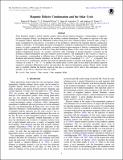Files in this item
Magnetic helicity condensation and the solar cycle
Item metadata
| dc.contributor.author | Mackay, Duncan Hendry | |
| dc.contributor.author | DeVore, C. Richard | |
| dc.contributor.author | Antiochos, Spiro | |
| dc.contributor.author | Yeates, Anthony Robinson | |
| dc.date.accessioned | 2018-12-14T17:30:07Z | |
| dc.date.available | 2018-12-14T17:30:07Z | |
| dc.date.issued | 2018-12 | |
| dc.identifier | 256867264 | |
| dc.identifier | a802d6f1-38e7-49ea-a41d-8d3a4e60efcc | |
| dc.identifier | 85058571622 | |
| dc.identifier | 000453051300005 | |
| dc.identifier.citation | Mackay , D H , DeVore , C R , Antiochos , S & Yeates , A R 2018 , ' Magnetic helicity condensation and the solar cycle ' , Astrophysical Journal , vol. 869 , no. 1 , 62 . https://doi.org/10.3847/1538-4357/aaec7c | en |
| dc.identifier.issn | 0004-637X | |
| dc.identifier.other | ORCID: /0000-0001-6065-8531/work/58055460 | |
| dc.identifier.uri | https://hdl.handle.net/10023/16694 | |
| dc.description.abstract | Solar filaments exhibit a global chirality pattern where dextral/sinistral filaments, corresponding to negative/positive magnetic helicity, are dominant in the northern/southern hemisphere. This pattern is opposite to the sign of magnetic helicity injected by differential rotation along east-west oriented polarity inversion lines, posing a major conundrum for solar physics. A resolution of this problem is offered by the magnetic helicity condensation model of Antiochos (2013). To investigate the global consequences of helicity condensation for the hemispheric chirality pattern, we apply a temporally and spatially averaged statistical approximation of helicity condensation. Realistic magnetic field configurations in both the rising and declining phases of the solar cycle are simulated. For the helicity condensation process, we assume convective cells consisting of positive/negative vorticities in the northern/southern hemisphere, which inject negative/positive helicity. The magnitude of the vorticity is varied as a free parameter, corresponding to different rates of helicity injection. To reproduce the observed percentages of dominant and minority filament chiralities, we find that a vorticity of magnitude 2.5 x 10-6 s-1 is required. This rate, however, is insufficient to produce the observed unimodal profile of chirality with latitude. To achieve this, a vorticity of at least 5 x 10-6 s-1 is needed. Our results place a lower limit on the small-scale helicity injection required to dominate differential rotation and reproduce the observed hemispheric pattern. Future studies should aim to establish whether the helicity injection rate due to convective flows and/or flux emergence across all latitudes of the Sun is consistent with our results. | |
| dc.format.extent | 21 | |
| dc.format.extent | 8819488 | |
| dc.language.iso | eng | |
| dc.relation.ispartof | Astrophysical Journal | en |
| dc.subject | Sun: activity | en |
| dc.subject | Sun: corona | en |
| dc.subject | Sun: magnetic fields | en |
| dc.subject | QB Astronomy | en |
| dc.subject | QC Physics | en |
| dc.subject | NDAS | en |
| dc.subject.lcc | QB | en |
| dc.subject.lcc | QC | en |
| dc.title | Magnetic helicity condensation and the solar cycle | en |
| dc.type | Journal article | en |
| dc.contributor.sponsor | Science & Technology Facilities Council | en |
| dc.contributor.sponsor | Science & Technology Facilities Council | en |
| dc.contributor.sponsor | The Leverhulme Trust | en |
| dc.contributor.institution | University of St Andrews. Applied Mathematics | en |
| dc.identifier.doi | https://doi.org/10.3847/1538-4357/aaec7c | |
| dc.description.status | Peer reviewed | en |
| dc.identifier.grantnumber | ST/K000950/1 | en |
| dc.identifier.grantnumber | ST/N000609/1 | en |
| dc.identifier.grantnumber | RPG-305 | en |
This item appears in the following Collection(s)
Items in the St Andrews Research Repository are protected by copyright, with all rights reserved, unless otherwise indicated.

